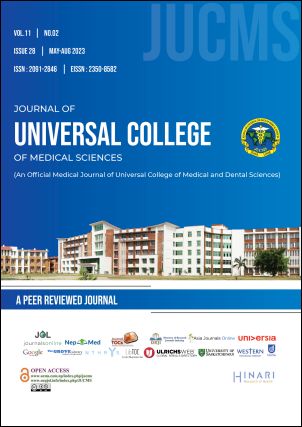Fetomaternal Outcome of Obstructed Labor in a Tertiary Care Centre
DOI:
https://doi.org/10.3126/jucms.v11i02.57986Keywords:
Obstructed labor, Maternal mortality, Perinatal mortality, PPH, Uterine ruptureAbstract
INTRODUCTION Obstructed labor is the leading cause of hospitalization. It is a preventable obstetric complcation. However, it is a major cause of maternal and perinatal morbidity and mortality. The main objective of the study was to find feto-maternal outcome in obstructed labor at tertiary care hospital UCMS-TH, Bhairahawa.
MATERIAL AND METHODS Eighty seven women admitted with features of obstructed labor at our hospital were studied. By clinical examination, diagnosis of cephalopelvic disproportion, malpresentation, malposition, obstruction in birth canal, overdistended bladder, hematuria, rupture uterus and supermoulding of fetal head was detected. Demographic profile of patients, mode of delivery, time interval between referral and admission, intervention done, intrapartum and postpartum complications, maternal and fetal outcome were evaluated.
RESULTS There were 87 cases of obstructed labor among 1655 total deliveries. Most common cause for obstructed labor was cephalopelvic disproportion (34.4%) followed by malpresentation (19.5%) and non progress of labor (17.2%). Majority of the patients were primigravida (43.6%) followed by multiparous (35.6%) and grand multipara (20.6%). Most of cases were unbooked and referral from primary health centers (80.4%). PPH (41.2%), extension of uterine incision (17.4%), followed by sepsis, pyrexia and uterine rupture were common complications. Perinatal morbidity due to obstructed labour requiring NICU admission was (33.9%) and perinatal mortality was (21.7%) mainly due to meconium aspiration, respiratory distress and septicemia.
CONCLUSION Cephalopelvic disproportion and primigravida were the commonest cause of obstructed labour and associated with PPH, extension of uterine incision, uterine rupture, sepsis and neonatal ICU admission and even neonatal death.
Downloads
Downloads
Published
How to Cite
Issue
Section
License
Copyright (c) 2023 Journal of Universal College of Medical Sciences

This work is licensed under a Creative Commons Attribution-NonCommercial 4.0 International License.
Authors have to give the following undertakings along with their article:
- I/we declare that this article is original and has not been submitted to another journal for publication.
- I/we declare that I/we surrender all the rights to the editor of the journal and if published will be the property of the journal and we will not publish it anywhere else, in full or part, without the permission of the Chief Editor.
- Institutional ethical and research committee clearance certificate from the institution where work/research was done, is required to be submitted.
- Articles in the Journal are Open Access articles published under the Creative Commons CC BY-NC License (https://creativecommons.org/licenses/by-nc/4.0/)
- This license permits use, distribution and reproduction in any medium, provided the original work is properly cited, and it is not used for commercial purposes.




